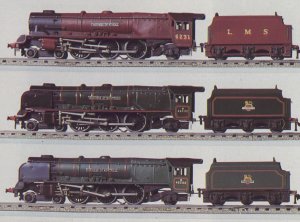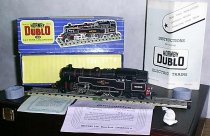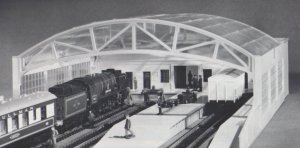Dublo History
| Autumn 1938: Initially just boxed sets (5 varieties in both electric and clockwork) available, with some wooden building accessories. 1939: More rolling stock appears and finally more accessories until wartime situation halts production and development. 1947: The four tank goods sets (only) reappear just in time for Christmas trade, with the new "Peco" coupling. Clockwork locos were never re-introduced. |
 |
 |
November 1948: The loco "Duchess of Atholl" with LMS coaches finally appear, in boxes sets only, having been advertised in 1939 but never produced. "Sir Nigel Gresley" returned, again only in boxed sets, revised to post-war appearance without valances over the driving wheels and numbered 7 instead of 4498. 1950: Improved, heavier, loco chassis introduced, with powerful new "Alnico" magnet replacing the Horseshoe type, and radio interference suppressor fitted. April 1953: Long-awaited announcement of Dublo stock in British Railways colours. The four private companies were represented previously, although from 1952 only LMS tank locos and goods sets were available. |
| October 1954: A new loco at last! (BR Standard 2-6-4 tank) along with suburban coaches. Some new all-diecast wagons had appeared earlier. 1957: Acceleration of new introductions, in the face of competition from other systems. First authentic Great Western loco, "Bristol Castle" introduced in October. November 1957: Plastic wheels and axles start to appear on rolling stock, as a prelude to introduction of a 2-rail system. |
 |
 |
December 1957: First of a range of Dublo Dinky-Toys. Previously hardly any Dinky-Toys were to 1:76 scale. February 1958: First "super-detail" goods wagon (bulk grain) with moulded plastic body. Tinplate-bodied wagons phased out, except for tank wagons. January 1959: A new system of 4-figure catalogue numbers introduced previous reference numbers were changed at least 3 times, and only printed in a public catalogue the previous year. The familiar blue boxes also changed to red for all items associated with 2-rail operation. |
| April 1959: 2-rail system officially announced, though full supplies were not available until Autumn. May 1959: The "Hornby-Dublo book of trains" announced, by far the most lavish publication on the subject of Meccano Ltd. It is revealed that although 3-rail components will continue to be available, boxed 3-rail sets are discontinued. September 1959: First plastic kit-form accessory (engine shed). Stations suitable for lower 2-rail track height followed in 1960. |
 |
 |
October 1960: New ring-field motor for "Castle" and class 8F 2-8-0 locos, but not applied to any earlier models. December 1960: Super-detail coaches, nearer to scale length than previous models, with plastic roof and body ends but retaining printed tinplate sides and steel underframes. Well-received by serious modellers. Plastic couplings first appeared on these models. Autumn 1961: The 3-rail steam loco models are re-vamped with some improvements and mainly new identities. In view of subsequent Company history, production was small, hence these models are scarce and relatively valuable. A new model of "West Country" 4-6-2 locos "Barnstaple" for 2-rail and "Dorchester" for 3-rail, is destined to be the last steam engine in the main system. |
| 1962: Many new wagons and coaches and an electric multiple unit. Can they keep up this expansion? 1963: The answer is no. Meccano Ltd. is now in serious financial difficulty, only 3 new models for this year. As an effort to increase business, a low quality "starter" set is introduced, with non-standard contents, marketed as a new range. A belated attempt is also made to simplify wiring for 2-rail points - the "Simplec type with insulated frog. February 1964: Meccano Ltd. shareholders accept a takeover bid by rival toymakers Lines Brothers, whose subsidiary Rovex Ltd. make Tri-ang. |
 |
 |
March 1964: The new owners announce the end of the 3-rail system, but allow some 2-rail manufacture to continue, including a new model of the A.C. electric loco E3002. December 1964: Actual end of Hornby-Dublo production, with the infamous track-cleaning wagon, believed to be the smallest production run in Hornby-Dublo. May 1965: Official announcement of the "amalgamation" of Hornby-Dublo with Tri-ang railways. In reality only the names "Hornby" survived. |
